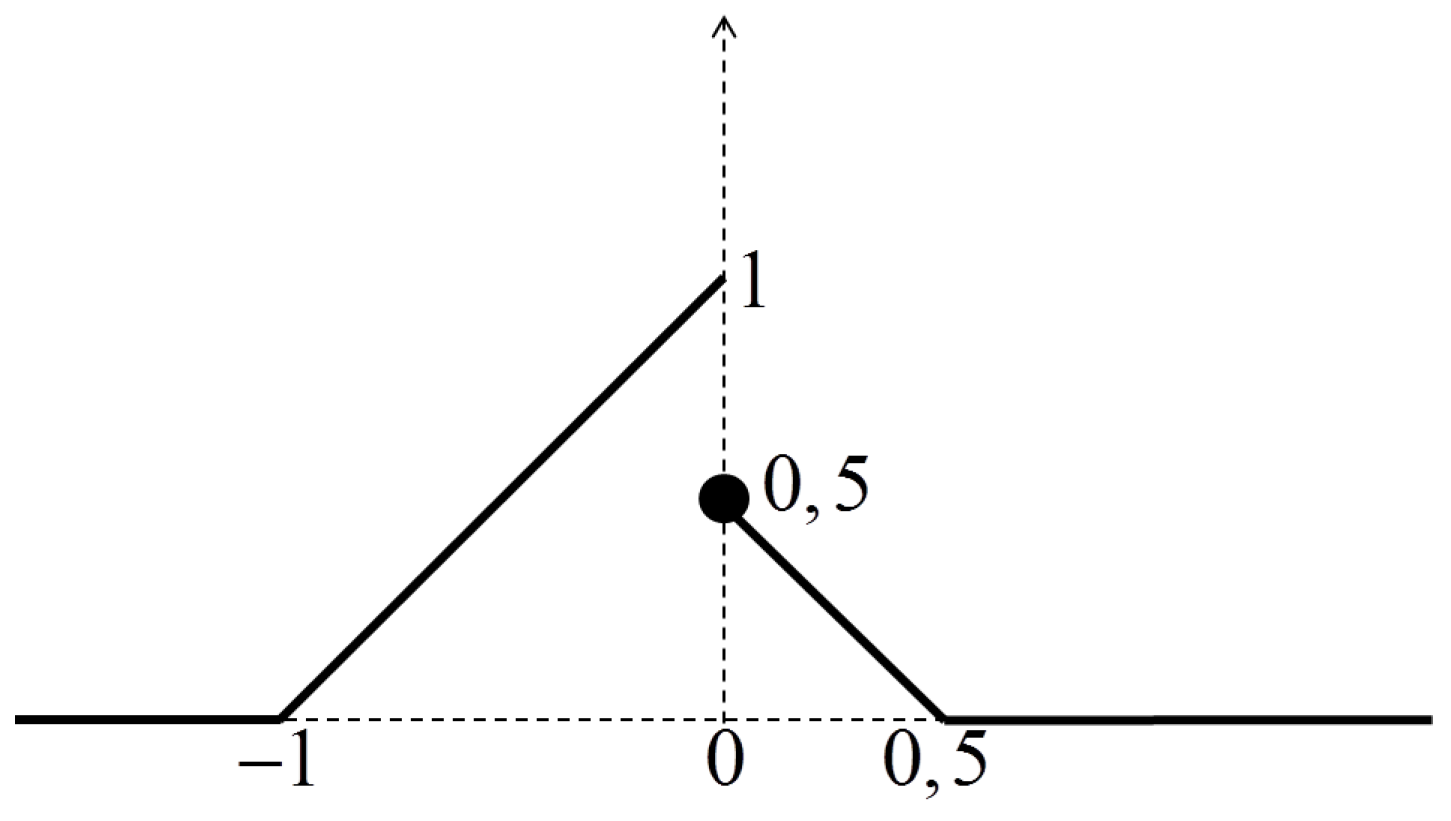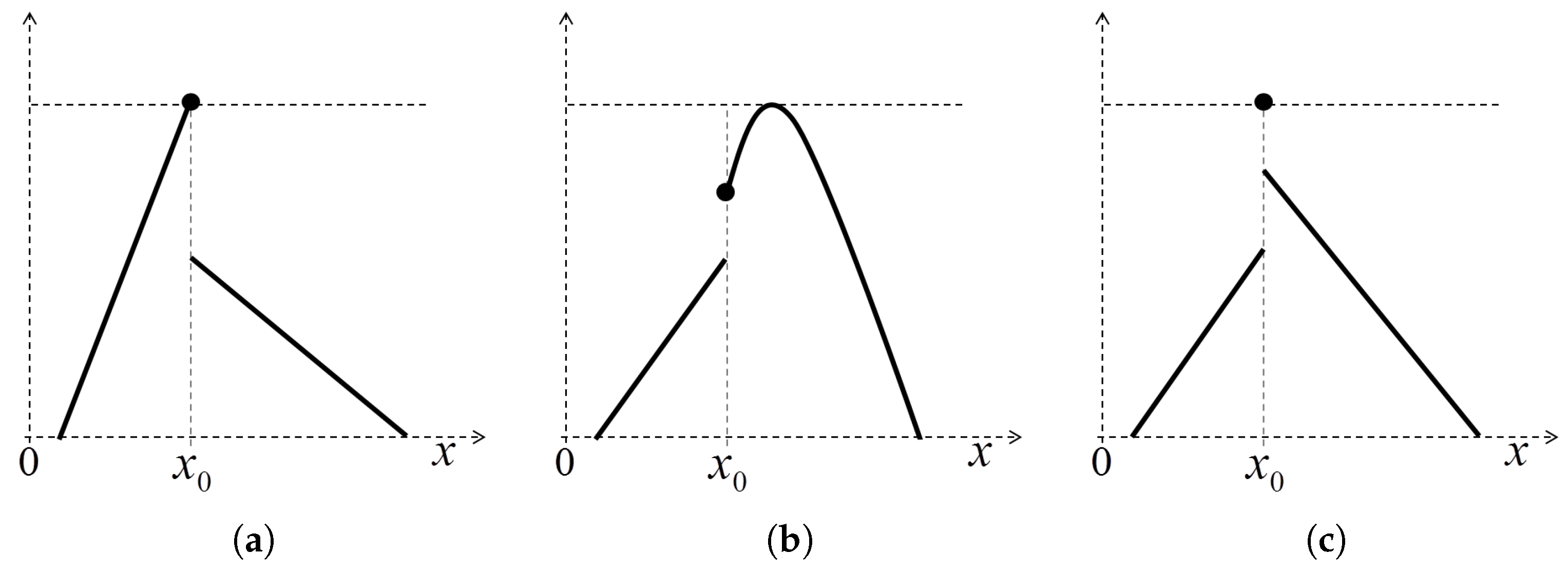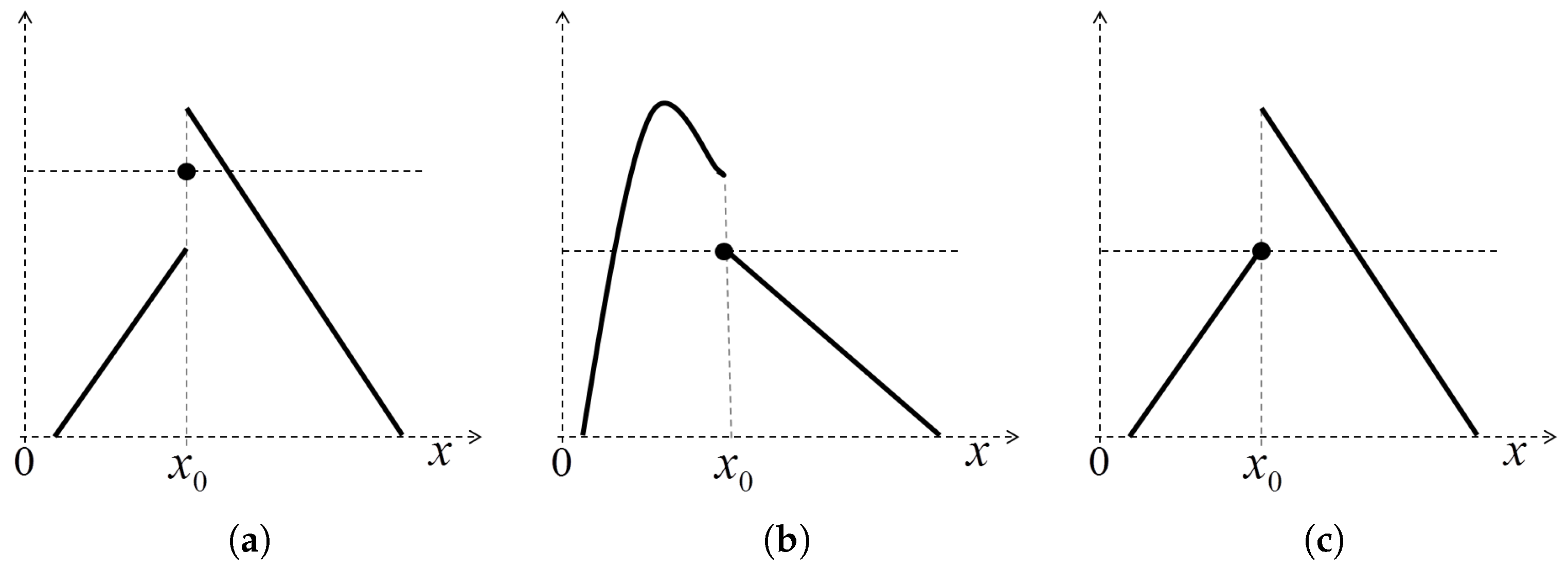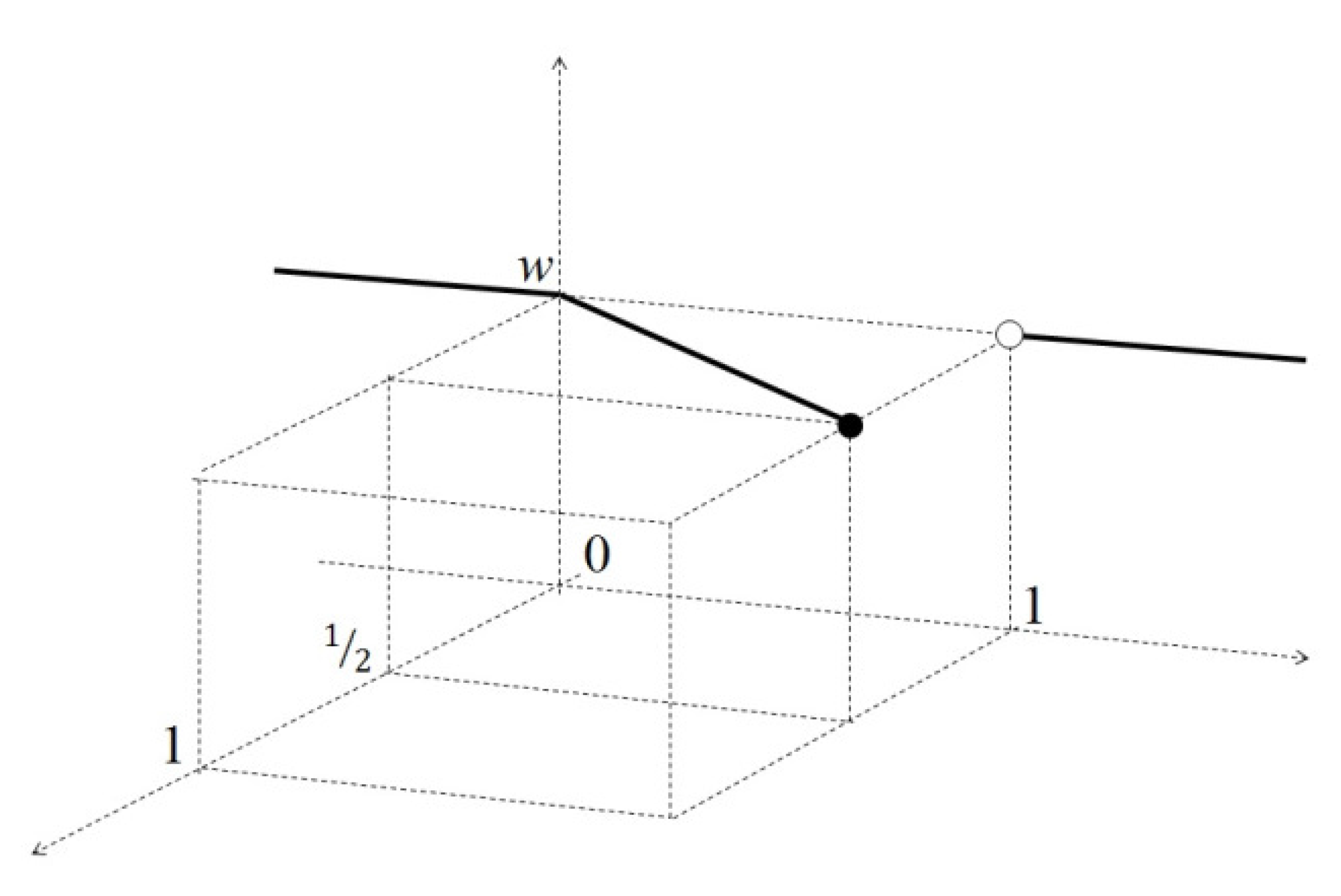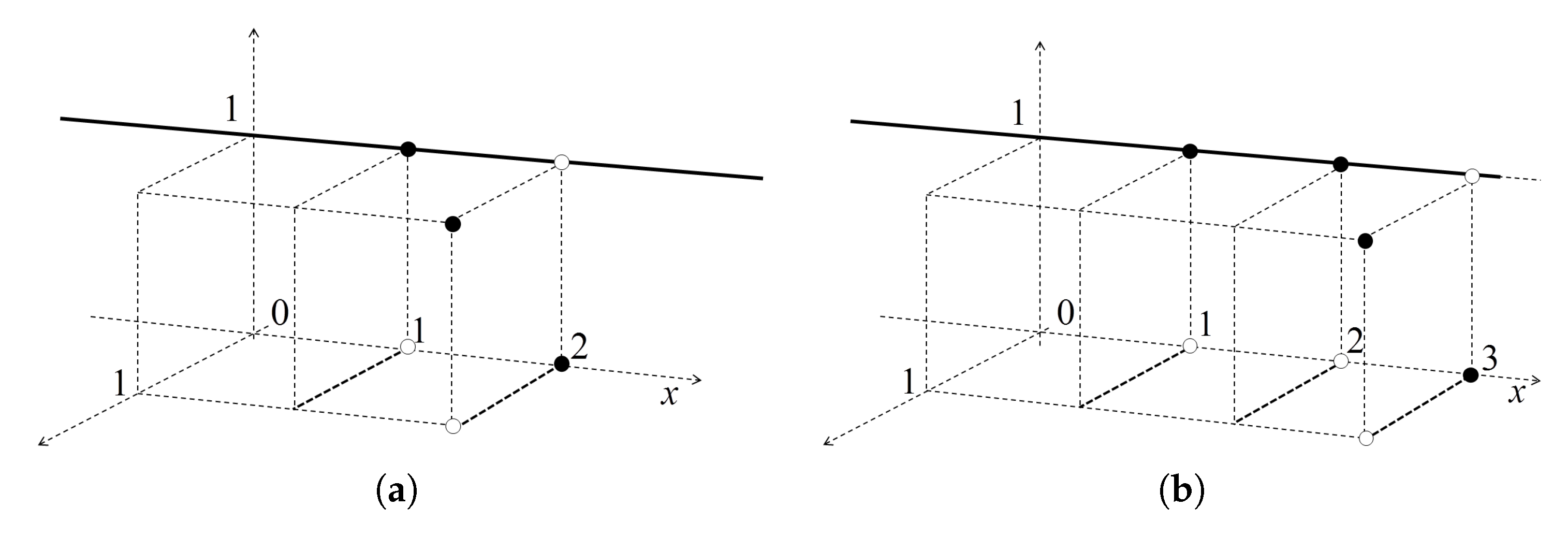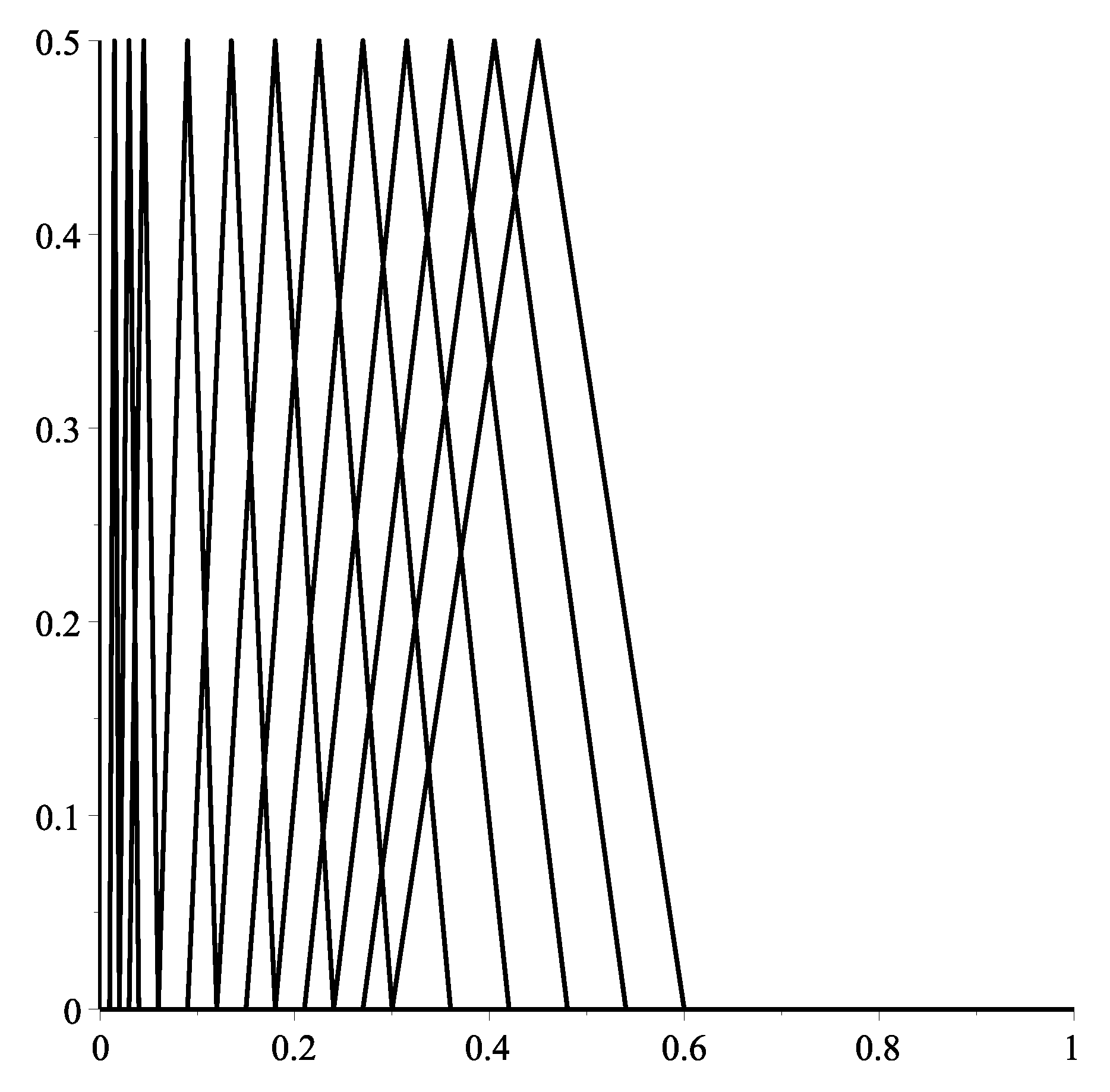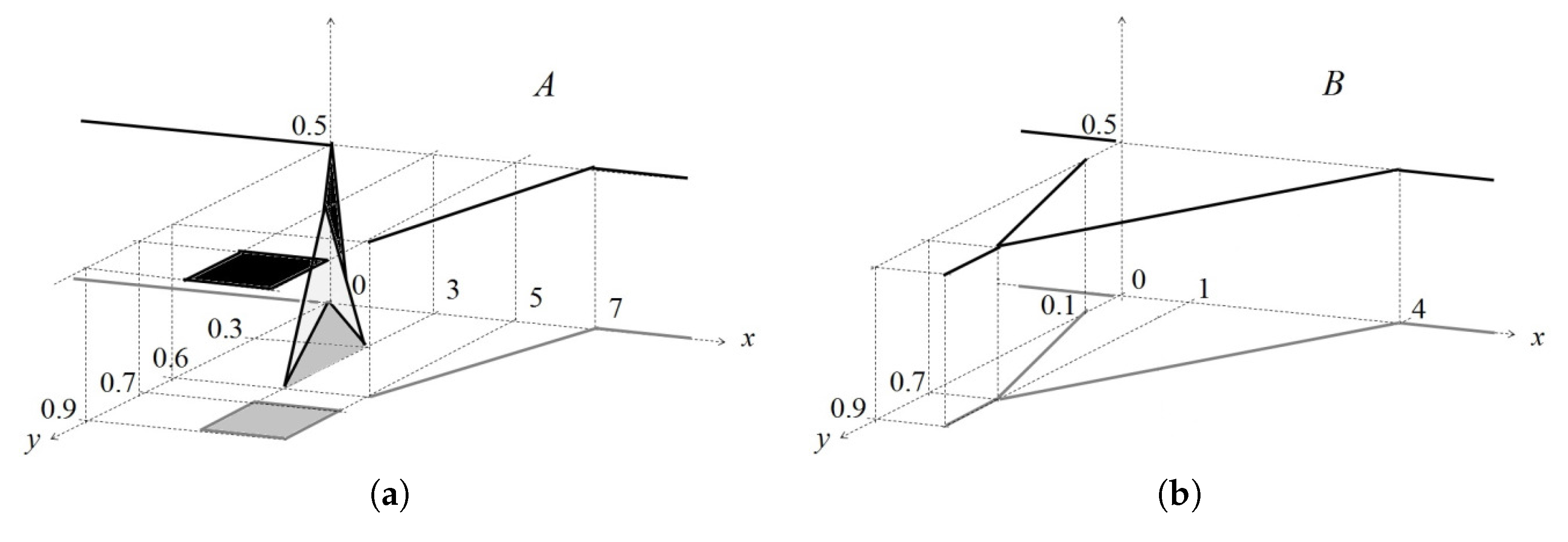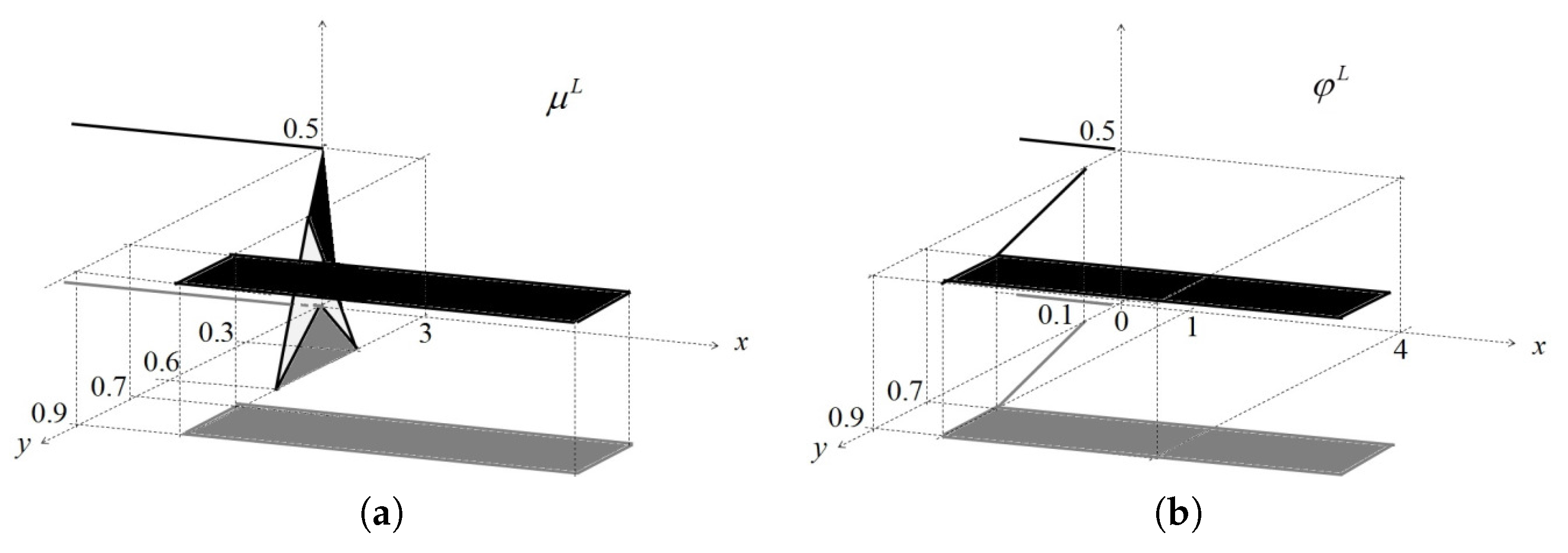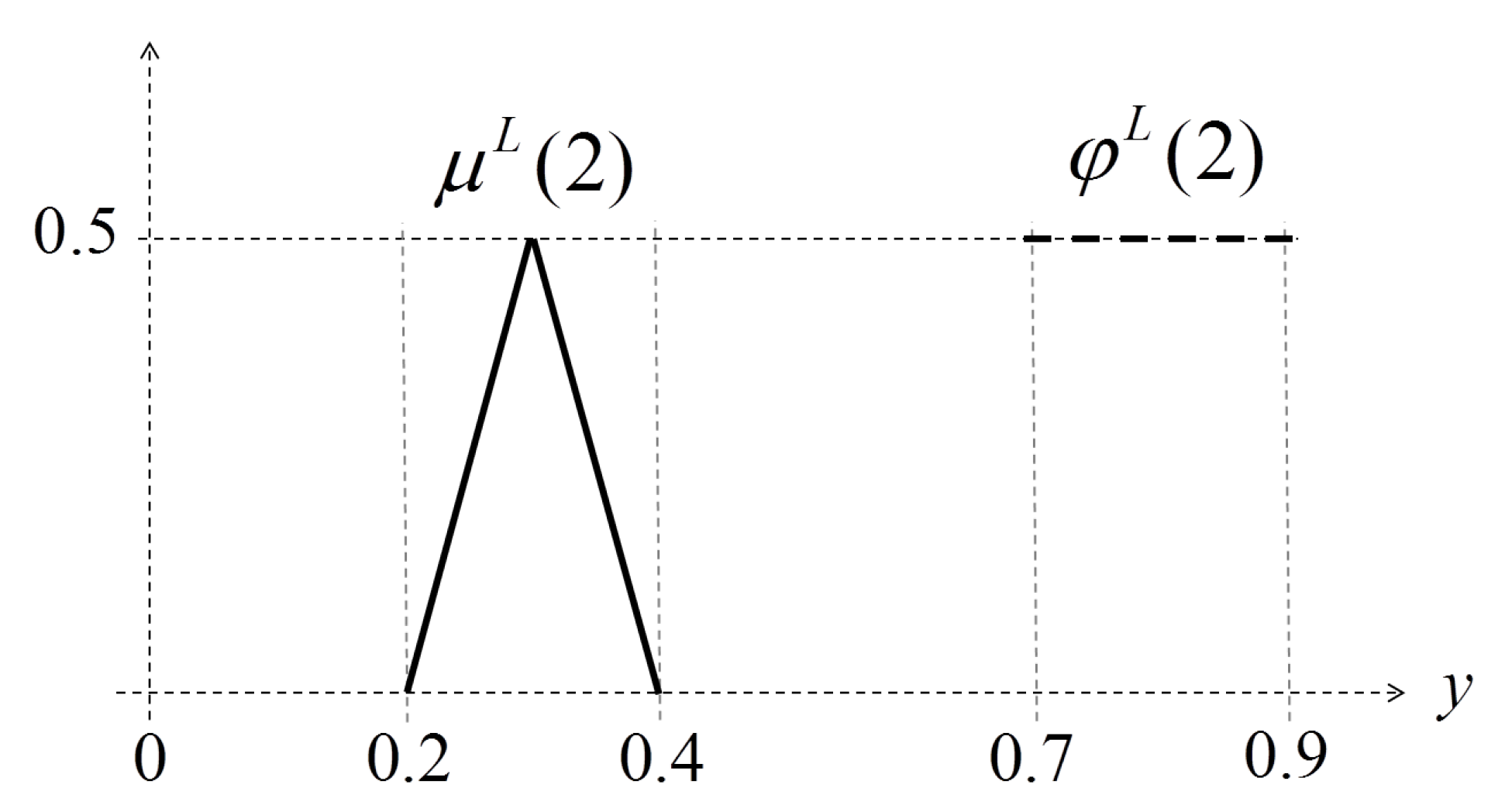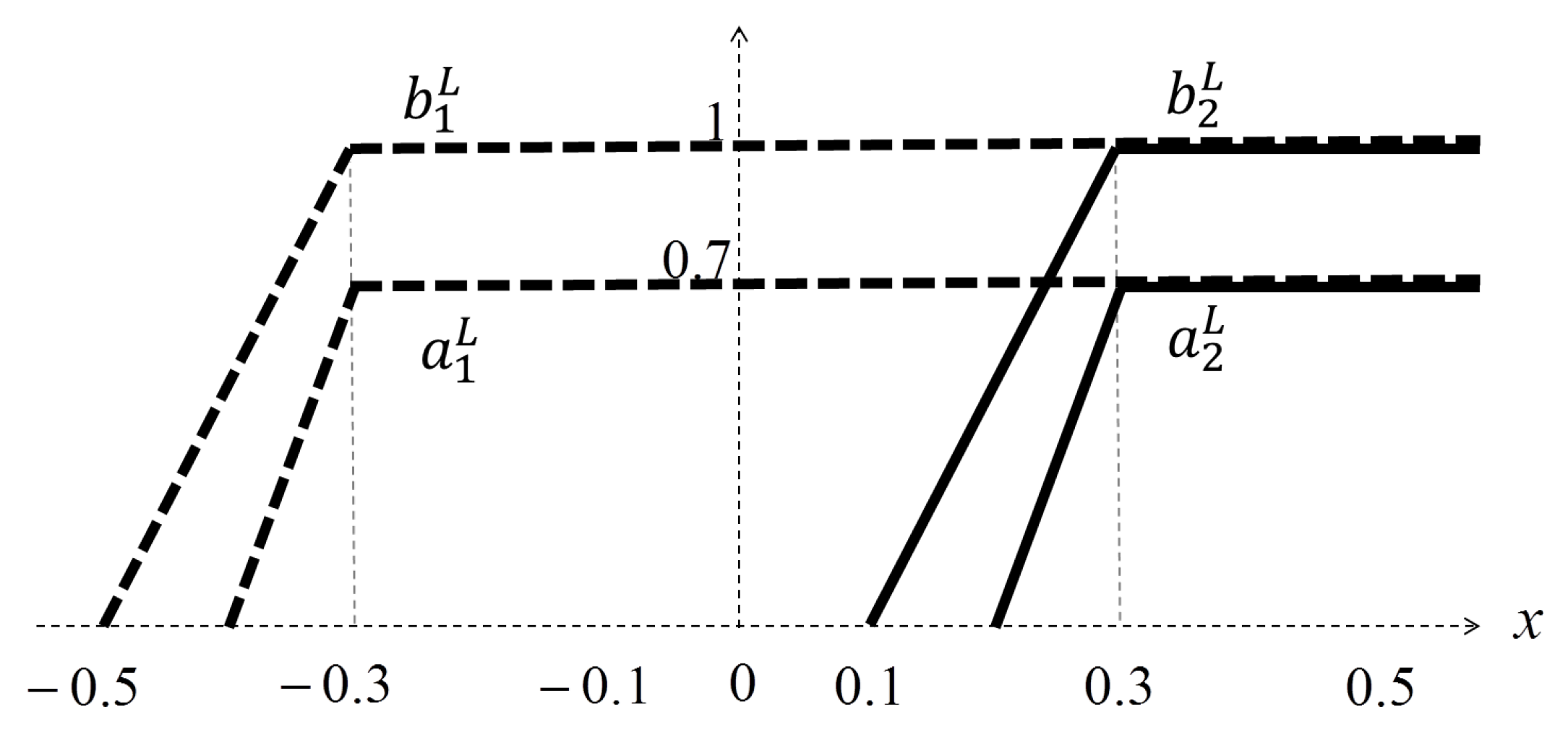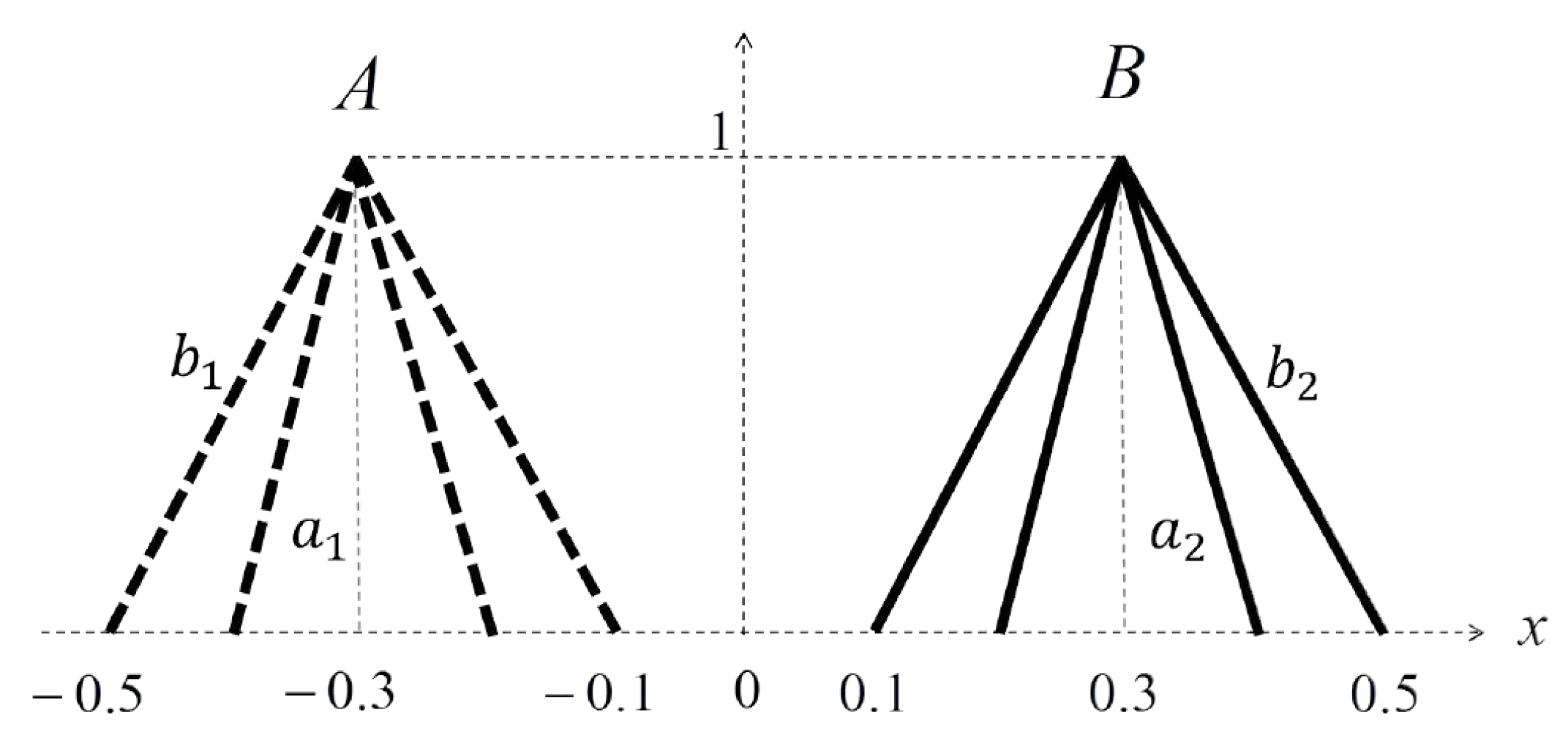1. Introduction
In the framework of fuzzy systems, in order to give a response or to make a decision, fuzzy numbers (FNs) and fuzzy quantities (FQs) need to be compared, i.e., to be ranked. In a sense, fuzzy numbers can be considered as real values with degrees of uncertainty, imprecision or vagueness. They are represented as fuzzy sets on the real line, that is, in general, they are not simply real numbers. Therefore, they cannot be compared by means of the usual total order on the set of real numbers. On the other hand, the pointwise partial order of functions, which is the standard order in the fuzzy sets, does not adequately (see
Section 2.1) extend the order of real numbers. However, from the horizontal representation of the extension principle, a partial order has been established (see Equation (
4)) in the FNs that extends the order of real numbers. Since Jain [
1,
2] and Dubois and Prade [
3] introduced the concept of fuzzy numbers, many authors (see, for example, [
2,
4,
5,
6,
7,
8,
9,
10,
11]) have given different methods that, although they do not produce total orders, allow one to compare the FNs and to order some of their subsets. Among these approaches are: statistical methods (see [
7,
10]), geometric methods (see [
8]), analytical methods (e.g., in [
6], the authors work with bounded variation functions), computational methods (e.g., artificial neural networks are applied in [
11]) or the combination of some of these.
Bortolan et al. [
12], Cheng et al. [
13] and, recently, Wang et al. [
14,
15] reviewed a variety of existing methods for comparing FNs. Moreover, the properties that every method must satisfy to compare reasonably FNs were discussed in [
14,
15].
On the other hand, since the introduction of extensions of fuzzy sets, the need to define and analyze fuzzy numbers in these extensions has been pointed out. For example, intuitionist fuzzy numbers (IFNs) and generalized intuitionist fuzzy numbers (GIFNs), which are intuitionistic sets on the real line satisfying certain conditions, were defined and studied in [
16,
17,
18]. Recently, interval type 2 fuzzy numbers (IT2FNs) have been defined in [
19,
20,
21,
22], as interval type 2 fuzzy sets (IT2FSs) on the real line fulfilling some properties. Besides, in [
19,
22], total preorders were given to ranking IT2FNs, but such preorders do not hold the property of antisymmetry, which is a theoretical and practical weakness. Moreover, the total preorder given in [
19] does not effectively extend the order of real numbers (see Example 2).
Type 2 fuzzy sets (T2FSs) are an extension of type 1 fuzzy sets (FSs), and IT2FSs are a particular case of T2FSs. Because the membership degrees of T2FSs are fuzzy, they are better able to model uncertainty than FSs [
23]. Fortunately, new methods have been introduced for the purpose of achieving a computationally-efficient and viable framework for representing T2FSs, as well as the T2FLS (type 2 fuzzy logic system) inference processes (see, for example, [
24,
25,
26,
27]). Thanks to these computational simplifications, the first applications of generalized T2FSs and not just interval type 2 fuzzy sets (IT2FSs), which is a subset of T2FSs, are now being reported, such as, for example, [
24,
26,
27].
In this paper, we define and compare type 2 fuzzy numbers (T2FNs) and type 2 generalized fuzzy numbers (T2GFNs), which are type 2 fuzzy sets (T2FSs) on the real line, with certain conditions. These sets are more general than the ones considered in [
19,
20,
22], so that in each application, the expert can choose the linguistic labels that best fit the specifications of the problem. We obtain a partial order in T2GFNs and in T2FNs, extending the order of real numbers, as a first step to obtain in future investigations a total order (or a preorder).
The paper is organized as follows. In
Section 2, we recall some definitions, basic concepts, partial orders and properties of the FNs and generalized fuzzy numbers (GFNs) of type 1 (
Section 2.1) and the T2FSs (
Section 2.2). In
Section 2.2, a partial order is introduced in the subset of T2FSs with convex membership degrees and with the same height. In
Section 3, we define and study the T2FNs and T2GFNs. A partial order is determined on the T2GFNs extending the order of the real numbers. Furthermore, among other examples, two IT2GFNs are ordered with our partial order, and the result is compared with the one obtained applying the preorder established in [
19].
Section 4 is devoted to some conclusions.
3. Type 2 Fuzzy Numbers
Haven et al. introduce in [
20] an extension of the fuzzy numbers, the interval type 2 fuzzy numbers (IT2FNs).
Definition 10. [20,22] An interval type 2 fuzzy number (IT2FN) is an IT2FS on , with membership function μ given by , where the functions are (type 1) fuzzy numbers. The function a is the lower membership function, and b is the upper membership function.
It is worth mentioning that this definition is also given in [
19] with
, where
b is a (type 1) fuzzy number, and
a is a (type 1) generalized fuzzy number (see Definition 3), i.e.,
a can be non-normal. Then, we call to these numbers given in [
19] the interval type 2 generalized fuzzy numbers (IT2GFNs).
Note that the set of IT2FNs is a subset of IT2GFNs.
Next, we introduce the definitions of type 2 generalized fuzzy number (T2GFN) and type 2 fuzzy number (T2FN). These sets are new extensions of fuzzy numbers and are also extensions of interval type 2 fuzzy numbers (see Proposition 1).
Definition 11. Given a T2FS on , with membership function , the support of μ is defined as:In addition, μ has bounded support if there exists such that , for all .
Remark 1. Given two closed intervals and , then , for all w, if and only if .
Definition 12. A type 2 generalized fuzzy number (T2GFN) in is a T2FS on , such that its membership function has bounded support, and moreover, there exists a such that μ is increasing in and decreasing in .
Example 3 shows two type 2 generalized fuzzy numbers.
Remark 2. Given a T2GFN in , with membership function μ, we have that:and therefore, for all , . Consequently, . Besides, the set is a point or an interval (not-empty) where μ is constant.
Remark 3. A type 2 fuzzy set on with membership function,is not a T2GFN, since there is no with the required conditions. Note that μ is increasing in , but not in , since, for instance, , but (see Figure 4; in this figure, only the image of the support of the functions corresponding to membership degrees has been drawn). Definition 13. A type 2 fuzzy number (T2FN) in is a T2GFN, such that: Remark 4. A type 2 fuzzy set on with membership function,is a type 2 generalized fuzzy number, but not a type 2 fuzzy number, since (see Figure 5; in this figure, only the image of the support of the functions corresponding to the membership degrees has been painted). Proposition 1. An interval type 2 fuzzy number (IT2FN), defined as in Definition 10, is a T2FN in .
Proof. The membership degree of any IT2FN is the characteristic function of an interval. That is, , where for all . The functions a and b are fuzzy numbers of type 1 (see Definition 4). Since a is strongly normal, we have for some . In addition, because , then , which implies that .
On the other hand, because a and b are fuzzy numbers and , we have that a and b are increasing in and decreasing in . Thus, and for all , which implies that . Consequently, is increasing.
In a similar way, we can prove that is decreasing in .
Therefore, the IT2FNs given in Definition 10 are a particular case of the T2FNs of Definition 13. ☐
Proposition 2. An interval type 2 generalized fuzzy number (IT2GFN) is a T2GFN in .
Proof. This is similar to the proof made for Proposition 1. ☐
It should be noted that the set of T2GFNs is a subset of the set of T2FSs on , whose membership degrees are functions in , so the following partial order, pointwise defined, can be induced: given two T2GFNs , we say that if and only if for all . However, this order is not convenient to compare T2GFNs, since it does not extend the natural order of real numbers, when these are represented as T2GFN, as is shown in Example 2.
Example 2. Let A and B represent the extension of real numbers 2 and 3 to the T2FSs, respectively, with membership degrees: Figure 6a shows the membership degrees
and
and only the image of the support of the rest of the membership degrees
.
Figure 6b displays the membership degrees
and
and only the image of the support of the rest of the membership degrees
.
It would be expected that as , but this does not happen since and , which implies that A and B are not comparable with that partial order.
Furthermore, the preorder given in [
19] does not extend the order of
either. In fact, in the above paper, the authors, before comparing numbers, transform the membership function of any real number, i.e.,
, to the real
or
, obtaining in this example that
.
Consequently, a partial order extending the total order of needs to be obtained on the T2GFNs. Before, we define two auxiliary functions.
Definition 14. Given a T2GFN with membership degree , we define the functions as follows: Proposition 3. Given a T2GFN in with membership function μ, we have for all x, and are increasing and decreasing functions, respectively, with respect to the partial order .
Proof. Since is increasing in and decreasing in for some , then , and , for all ; therefore , for all .
Similarly, we have for all and for all ; therefore , for all . In addition, it follows that and are increasing and decreasing functions, respectively, with respect to the partial order . ☐
Remark 5. Given a T2GFN in with membership function μ and a point where μ reaches the supremum, as , it is clear that: Definition 15. Let A and B be T2GFNs in , with membership function and respectively. We define the relation as:for all . Proposition 4. Let A and B be T2GFNs in , with membership functions and , respectively. If A and B are comparable with , then: Proof. If
then
and
for all
. From the Remark 5, we have:
Since ⊑ is antisymmetric, we have:
☐
Proposition 5. Let A and B be two T2GFNs in , with membership functions and , respectively. If , then , being and .
Proof. If , then . Suppose , then there exists such that and by Proposition 4, but . Therefore, , which is impossible. ☐
Proposition 6. is a partial order in the set of T2GFNs in .
Proof. Let be three T2GFNs in , with membership functions and , respectively.
Reflexivity: As ⊑ is a partial order in , it is reflexive, and thus, and , for all x. Therefore, .
Transitivity: If
and
, then, for all
, we have that:
Since ⊑ is transitive, we have that:
for all
x. Therefore,
Antisymmetry: If , then and . Additionally, if , then and .
Since ⊑ is antisymmetric, then:
for all
x.
As A and B are T2GFNs, their membership functions are increasing in and , respectively, and decreasing in and , respectively, for some . Therefore, , for all ; , for all ; , for all ; and , for all .
Without loss of generality, we suppose . If , then we have . If , then we have .
On the other hand, if , we obtain and . Since ⊑ is antisymmetric, we have that for all x. Therefore, . ☐
Remark 6. The partial order of Definition 15 extends the order of . In fact, let A and B be the extensions in the T2FNs, of the real numbers a and b, respectively, such that , with membership functions: In this case, we have that: One can prove that and for all x. Then, , but and (see Example 2).
Note that the methods provided in [
19,
22] for ranking IT2FNs are total preorders; however, to the best of our knowledge, there is no previous work where a partial order is established extending the order of the real numbers to T2FNs and not just to IT2FNs or IT2GFNs. Moreover, as has already been pointed out, the preorder in [
19] does not extend the order of
; meanwhile, it can be proven that the preorder in [
22] does extend it. Example 3 shows the ranking of two T2GFNs that are not IT2FNs.
Example 3. Consider the two T2GFNs A and B given by the degrees of membership , respectively, defined below. Note that A and B are not IT2FNs (see Definition 10), because , and some membership degrees of A are not characteristic functions of a point or an interval.
Let be defined by:
if , then ;
if , then
if , then ;
if , then .
In
Figure 7, we only show the membership degrees of the set
, when
. In the other case, when
, the membership degrees are characteristic functions of a point or an interval with height
. In
Figure 8, on the left, we have drawn the images of the supports of the membership degrees of the set
A, as well as the projection of these values on the plane
.
Additionally, let be defined by:
if , then ;
if , then ;
if then ;
if , then .
All membership degrees of the set
B are characteristic functions of a point or an interval with height
. On the right of
Figure 8, we have drawn the image of the support of each membership degree of the set
B, as well as the projection of these values on the plane
.
In this example,
and
; therefore, for all
and
, it is:
In addition, we have:
is such that (see
Figure 9):
if , then ;
if , then ;
is such that (see
Figure 10):
if , then ;
if , then .
is such that (see
Figure 9):
if , then ;
if , then ;
is such that (see
Figure 10):
if , then ;
if , then .
Comparing
with
and
with
respect to the partial order
, we can prove
and
for all
. Therefore,
For example, from
Figure 11, it follows that
and
, for all
, and then,
.
Remark 7. As mentioned before, in [19,22], total preorders for ranking IT2FNs were provided. One of the disadvantages of these preorders is that they do not satisfy the property of antisymmetry; therefore, two elements can be considered as equal, when they are not, which undoubtedly affects the decision making. On the other hand, from a theoretical point of view, operating or working with preorders adversely affects the consolidation of a consistent and coherent algebraic structure. A solid algebraic structure allows, among other things, the correct determination and application of operators (e.g., negations, t-norms, aggregation operators, among others). Besides, these preorders given in [19,22] reduce each IT2FN to a real value and finally compare these real values with the order of the real numbers, which implies some loss of the information (representation of the uncertainty, impression and vagueness) contained in the original form of each IT2FN. On the other hand, the partial order guarantees the algebraic properties of posets. Furthermore, with the partial order , the loss of information is minor compared to those preorders. One of the disadvantages of this partial order is that it is not total; therefore, there are elements that are non-comparable with it. Considering the above, the ideal is to have a total order, extending the order of the real numbers in the T2FNs; however, a partial order is a good starting point to obtain some total order. Anyway, it would be suitable, for ranking IT2FNs or IT2GFNs, firstly to apply the order , and if they are not comparable, then to apply the above-mentioned preorders. It should be noted that in [19], it was established that any method to ranking IT2FNs must be consistent with the human intuition, in the sense that the more to the right an IT2FN is, the greater it will be. That is, the more to the right the centroid of an IT2FN is, the greater it will be. This property is satisfied by the order . Example 4 shows two IT2GFNs previously ranked in [
19] with the preorder CPS (centroid point and spread). We rank them with
, obtaining the same decision as the one achieved with the CPS method. However, before, in the next Proposition 7, we give the characterization of
, when ranking IT2GFNs exclusively.
Proposition 7. Let A, B be two IT2GFNs, with membership degrees and , respectively, , then: Proof. This is directly according to Definition 15, Remark 1, Proposition 5 and the usual partial order in the closed intervals, . ☐
Example 4. Let be two IT2GFNs, with membership degrees and , , respectively, whose supports are shown in Figure 12. In [19], Section 4, Case 3, these IT2GFNs, , were ranked with the CPS method, and it was obtained that B is greater than A. On the other hand, we apply the order , according to Figure 13 and Figure 14 and Proposition 7, and we obtain the same above result, i.e, (). In Figure 13 and Figure 14, note that ; therefore, (). Now, comparing the IT2FNs
A and
B in
Figure 15 with the preorder given in [
22] (
), it results
and
and also
. Moreover, it can be proven that for any IT2FNs
A and
B, if
, then
.
Finally,
Table 1 shows the properties fulfilled by each ranking method mentioned in this paper. Remember that:
denotes the relation defined in Definition 15;
denotes pointwise extension of the partial order ;
denotes pointwise extension of the partial order of the intervals ;
denotes the relation given in [
19];
denotes the relation given in [
22].
